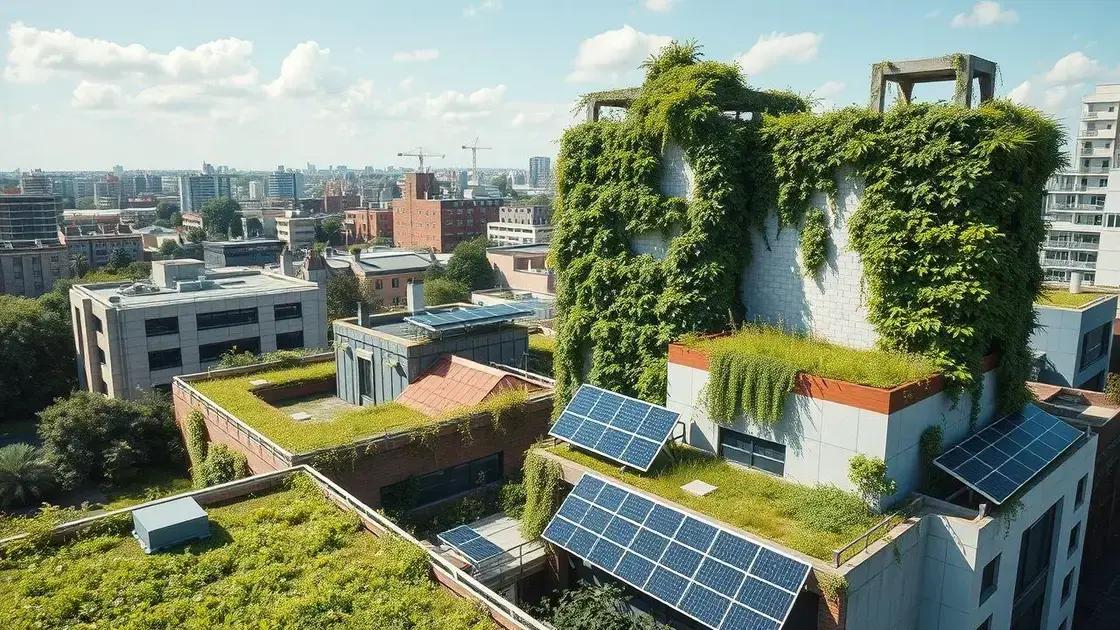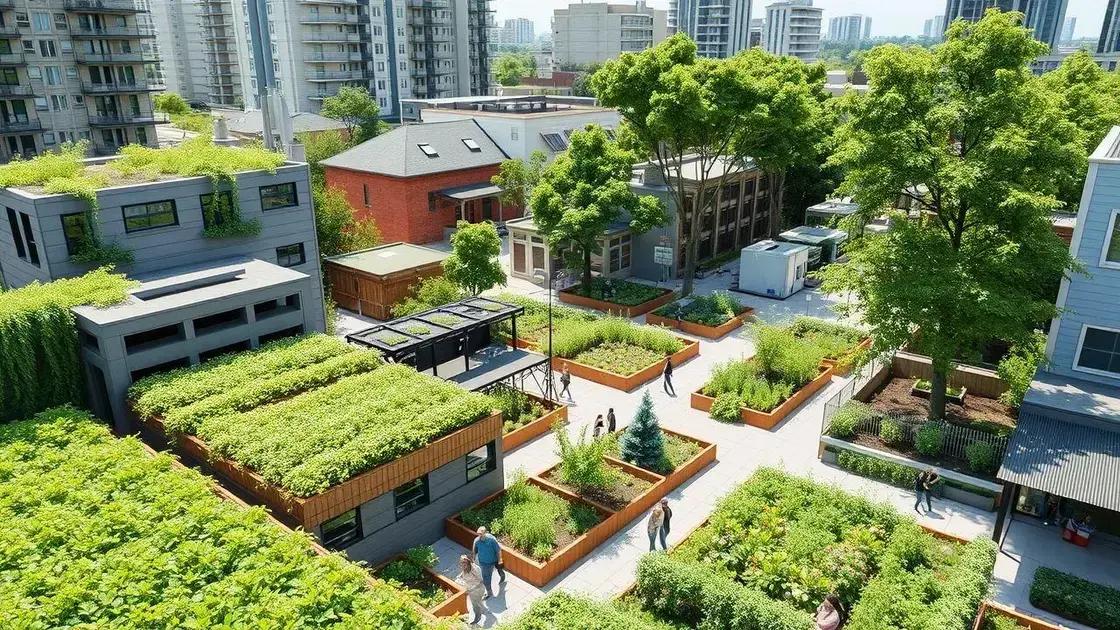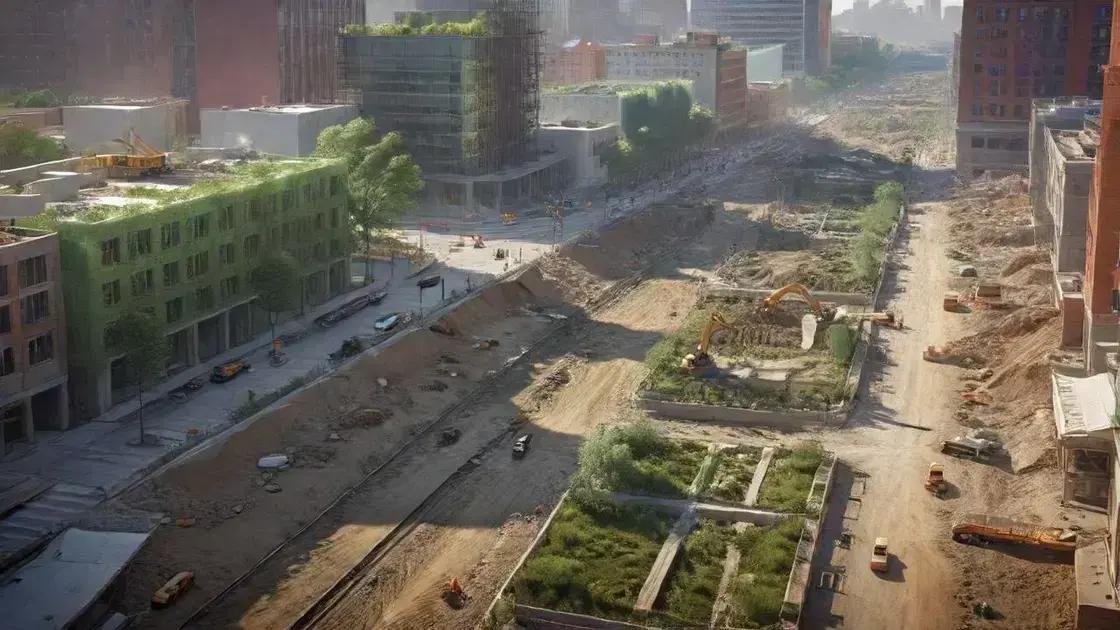Green infrastructure headlines trends: the future of urban landscaping

Green infrastructure refers to natural and semi-natural systems integrated into urban planning that enhance sustainability, improve air quality, manage stormwater, and promote biodiversity while addressing challenges like financial constraints and regulatory hurdles.
Green infrastructure headlines trends are transforming our cities, offering sustainable solutions that improve urban life. Have you noticed how green spaces are becoming essential for city planning? Let’s dive into these innovative approaches that blend nature with infrastructure.
Understanding green infrastructure and its benefits
Understanding green infrastructure is essential for creating sustainable urban environments. This concept goes beyond just adding green spaces; it’s about integrating nature into our cities in a way that benefits both the ecosystem and the community.
What is Green Infrastructure?
Green infrastructure refers to a network of natural and semi-natural systems that provide environmental, economic, and social benefits. It includes parks, green roofs, permeable pavements, and even urban forests. Each component plays a vital role in improving urban landscape resilience.
Benefits of Green Infrastructure
Implementing green infrastructure comes with numerous advantages:
- Reduces stormwater runoff
- Improves air quality
- Enhances urban aesthetics
- Supports local biodiversity
By investing in these solutions, cities can tackle challenges like flooding and pollution while also promoting healthier living conditions. Imagine walking through a neighborhood adorned with greenery, which not only looks inviting but also functions effectively as a drainage system.
Moreover, green infrastructure can lower urban heat levels. Vegetation cools the air, making communities more comfortable during hot summers. This cooling effect can also reduce energy costs for air conditioning, contributing to lower utility bills for residents.
As we explore more about green infrastructure, it’s important to recognize how these interventions are adaptable to different urban settings. These solutions can be tailored to specific local conditions, maximizing their effectiveness and community acceptance.
Trends driving the adoption of green infrastructure

Trends driving the adoption of green infrastructure are reshaping urban landscapes around the world. As the impacts of climate change become more apparent, cities are increasingly turning to nature-based solutions to address pressing environmental issues.
Growing Awareness of Environmental Issues
A key trend influencing green infrastructure is the rising public awareness of environmental challenges. Communities are advocating for sustainable practices, leading to increased demand for greener spaces. Residents are looking for ways to improve air quality, manage stormwater, and enhance urban biodiversity.
Government Initiatives and Policies
Many governments are implementing policies that encourage the adoption of green infrastructure. These initiatives often provide funding for projects that incorporate green roofs, rain gardens, and urban forests. Such policies aim to reduce urban heat, enhance public spaces, and create healthier living environments.
- Incentives for green roofing installations
- Grants for community garden projects
- Legislation promoting green building standards
- Support for sustainable land use planning
As these policies take effect, more cities are launching innovative projects that highlight the benefits of integrating nature into urban areas. Citizens are becoming more engaged, pushing for initiatives that align with community needs.
Technological advancements also play a significant role in promoting the adoption of green infrastructure. Smart technologies enable better monitoring and management of green spaces. For instance, using sensors in urban greenery can help track moisture levels, ensuring proper irrigation. These innovations pave the way for more effective maintenance and resource allocation.
Real-world examples of successful green infrastructure
Real-world examples of successful green infrastructure illustrate how cities worldwide are implementing innovative solutions to address environmental challenges. These projects not only enhance urban aesthetics but also contribute to sustainability and community well-being.
New York City’s Green Roofs
New York City has become a leader in green infrastructure through its ambitious green roof initiatives. By installing green roofs on buildings, the city aims to reduce urban heat, improve air quality, and manage stormwater effectively. These installations create vibrant habitats for local wildlife while providing recreational spaces for residents.
Philadelphia’s Stormwater Management Program
Philadelphia has adopted a comprehensive stormwater management program that emphasizes green infrastructure. By incorporating rain gardens, permeable pavements, and green roofs, the city efficiently manages rainwater runoff. This approach reduces flooding risks and enhances the overall quality of water in local rivers.
- Implemented over 10,000 greened acres
- Incorporated over 100,000 square feet of green roofs
- Improved water quality in local streams
These projects demonstrate how urban areas can leverage green infrastructure to create healthier, more resilient environments. Meanwhile, communities have noticed a significant transformation in their neighborhoods, making them more livable and enjoyable.
Another exemplary case is in San Francisco, where the city has integrated green infrastructure into its urban planning. The city features bioswales and street trees that aid in stormwater capture and filtration. These measures not only improve drainage but also promote biodiversity and enhance urban green spaces.
Challenges in implementing green infrastructure solutions

Challenges in implementing green infrastructure solutions can be significant, often hindering progress towards sustainable urban development. While these solutions offer many benefits, obstacles can arise during planning and execution.
Financial Constraints
One of the primary challenges is the cost associated with installing and maintaining green infrastructure. Many municipalities face budget limitations that make it difficult to allocate necessary funds to these projects. Investments in green roofs, permeable pavements, and rain gardens can be high, and securing financial backing remains a concern.
Regulatory Hurdles
Navigating the regulatory landscape can pose another challenge. Different cities have varying regulations regarding land use and environmental impact. Ensuring that green infrastructure solutions comply with local laws can complicate the implementation process.
- Complex permitting processes
- Conflicting interests among stakeholders
- Varying local regulations
Additionally, potential conflicts among community stakeholders can delay or even derail projects. Some residents may resist changes to their neighborhoods, seeking to maintain existing landscapes or fearing increased maintenance responsibilities.
Another significant issue is the lack of adequate knowledge and technical expertise. Implementing green infrastructure requires specialized skills, and a shortfall of trained professionals can slow progress. Without adequate training, municipalities may struggle to design, construct, and maintain effective green systems.
FAQ – Frequently Asked Questions about Green Infrastructure
What is green infrastructure?
Green infrastructure refers to a network of natural and semi-natural systems that provide environmental, economic, and social benefits in urban environments.
What are the benefits of implementing green infrastructure?
Implementing green infrastructure improves air quality, manages stormwater effectively, reduces urban heat, and enhances urban biodiversity.
What challenges can cities face when adopting green infrastructure solutions?
Cities may face financial constraints, regulatory hurdles, community resistance, and a lack of technical expertise when implementing green infrastructure.
How can communities support green infrastructure projects?
Communities can support green infrastructure projects by advocating for local policies that promote sustainability and participating in planning processes.





